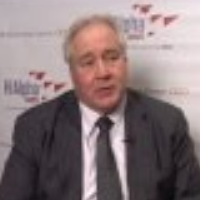Canadian Company to Defy Ban on Uranium Mining Near Grand Canyon
 Stephen Anthony, president and CEO of Energy Fuels, Inc.
Stephen Anthony, president and CEO of Energy Fuels, Inc.
A Canadian mining company is using a 27-year-old environmental impact study to evade President Barack Obama’s ban on new mining near Grand Canyon National Park, but activists and a Native American tribe have filed suit to stop the re-opening of its abandoned uranium mine six miles south of the canyon's South Rim entrance, which attracts nearly 5 million visitors a year.
Colorado-based Energy Fuels Resources, a subsidiary of Toronto-based Energy Fuels, Inc. (2012 revenues: $25 billion), argues that the January 2012 Obama administration policy barred only new claims on the one million acres surrounding the park. Because the company's “Old Canyon mine” received regulatory approval and opened in the 1980s, only to close in 1992 as the price of uranium fell, Energy Fuels did not file a new claim, instead persuading the U.S. Forest Service to approve the mine’s re-opening based on environmental and other regulatory approvals issued in 1986.
Arguing that a lot has happened since 1986, the Grand Canyon Trust, the Center for Biological Diversity, the Sierra Club and the Havasupai Indian Tribe filed suit in March to stop the reopening. They contend that several factors required the Forest Service to mandate new studies of the mine's impact.
These include several changes to the mine project itself, such as additional conservation measures required by the reintroduction of the California condor, replacement of the liner on the on-site storm water and waste water pond, and the expansion of the on-site storm water pond. New circumstances and information relating to the mine’s environmental impact have also arisen, such as on-site storage in stockpiles of waste rock, increased populations in local communities, and the regulation of radon under the Clean Air Act.
Finally, the plaintiffs point out that the Forest Service’s designation of the Red Butte area, where the mine is located, as a Traditional Cultural Property of the Havasupai Indian tribe under the National Historic Preservation Act also triggers protections that were not available in 1986 and that have never been considered.
Energy Resources disagrees. Spokesman Curtis Moore contends that “The Forest Service looked at that review with modern eyes and determined that it's adequate. And 1986 was not that long ago. These are tiny mines–about 20 acres.”
But Roger Clark of Grand Canyon Trust says size is not the issue, and points out that the mine could pollute the nearby Red Wall aquifer, “the main source of water to the Grand Canyon besides the Colorado River. Once that aquifer is contaminated, there’s no turning back,” warns Clark.
-Matt Bewig
To Learn More:
Grand Canyon Uranium Mining Set to Go Ahead Despite Ban from Obama (by Leslie Macmillan, The Guardian)
Uranium Mine by the Grand Canyon to Reopen despite Obama’s Ban (by Cecilia Jamasmie, Mining.com)
Grand Canyon Trust, et al. v. Michael Williams, et al. (U.S. District Court for Arizona) (Complaint) (pdf)
- Top Stories
- Unusual News
- Where is the Money Going?
- Controversies
- U.S. and the World
- Appointments and Resignations
- Latest News
- Trump to Stop Deportations If…
- Trump Denounces World Series
- What If China Invaded the United States?
- Donald Trump Has a Mental Health Problem and It Has a Name
- Trump Goes on Renaming Frenzy






Comments